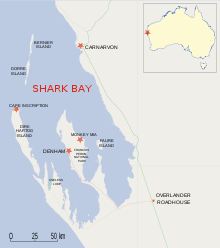Dirk Hartog Landing Site 1616
The Dirk Hartog Landing Site 1616 is of great importance for the discovery of Australia . The northwestern tip of Dirk Hartog Island in Western Australia , which the Dutchman Dirk Hartog set foot on in 1616, was not only the starting point for exploring the western side of Australia, but also for the fact that Australia was inscribed on world maps and settled by Europeans over time . The Dirk Hartog Landing Site 1616 was declared a national monument by the Australian federal government, the Commonwealth, in 2006.
Cape Inscription
Dirk Hartog of the Dutch East India Company sailed westwards on the Eendracht (German: Eintracht ) in the direction of Batavia in 1616 . He landed on October 25, 1616 on Dirk Hartog Island, named after him, and mapped the coast. To document his landing on the west coast, on what was then Terra Australis Inkognita , he left a plaque made of pewter there .
This badge is the first documented landing by Europeans on what was then called the land of “New Holland”. After this landing, this place was marked on the world maps, and as a result, other Dutch, French and British explorers came to the area in the centuries that followed.
The next discoverer was Willem de Vlamingh on February 4, 1697 , what is now known as the Cape Inscription and placed his own plaque next to Hartog's. Vlamingh's plaque was found by Jacques Félix Emmanuel Hamelin , who was taking part in the Baudin expedition in 1801, and he enclosed a lead foil with inscriptions. Louis de Freycinet came to the Cape in 1818 and took the Vlamingh plaque, which the French government returned in 1947.
Phillip Parker King , son of early Governor Philip Gidley King , also left a record of his arrival at Cape Inscription in 1822 when he was completing Matthew Flinders' maps . In 1858, Henry Mangles Denham came to Cape Inscription when he was making hydrographic maps.
The badge of Hartog is in the Rijksmuseum Amsterdam in the Netherlands, the other either in the territory of Carnarvon or the Maritime Museum of Fremantle in Western Australia.
Because of its historical significance for the history of discovery in Australia, the Cape Inscription was entered on the Australian National Heritage List , and the adjacent Shark Bay World Heritage Area has been a UNESCO World Heritage Site since 1991 .
Other historic landing sites
Other important landing sites were Dampier Landing and Turtle Bay on Dirk Hartog Island. In 1699 William Dampier landed on the northwestern part of this island at the place named after him and in 1772 the French navigator Francios de Saint Allouarn on Turtle Bay , who dug two bottles with a French coin there. One of the bottles with a coin and a lead cap was found again in 1998.
Web links
- environment.gov.au (PDF; 164 kB): Map of Cape Inscription and Turtle Bay (English)
Individual evidence
- ↑ a b c environment.gov.au ( Memento of the original from August 22, 2011 in the Internet Archive ) Info: The archive link was inserted automatically and has not yet been checked. Please check the original and archive link according to the instructions and then remove this notice. (PDF; 661 kB): Dirk Hartog Landing Site 1616, Cape Inscription Area , in English, accessed on September 29, 2011
- ↑ environment.gov.au : Dirk Hartog Landing Site 1616 - Cape Inscription Area, Western Australia , in English, accessed September 29, 2011
Coordinates: 25 ° 30 ′ 34.6 ″ S , 112 ° 58 ′ 55.3 ″ E

